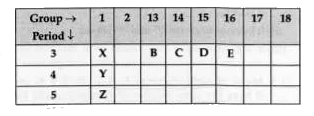Consider the part of the periodic table given below and answer the following questions.

i) The atom of which element is smaller in size? e or h.
ii) Which element is most lectropositive in nature?
iii) Which element has only one proton in its atom?
iv) What is the valency of g?
v) How many valence electrons does g have?
vi) Name the element which is a metallold.
(i) Element h is smaller in size than e since atomic size decreases across a period.
ii) Element d is most electropositive since electropositive character increases down a group and decreases across a period,
iii] Element a (hydrogen) has only one proton in its atom.
iv] Valency of g is 2.
v] Element g has 6 valence electrons.
vi] Element f (silicon) is a metalloid.
Similar Questions
In the following table, the positions of six elements A, B, C, D, E and F are given as they are in the Modern Periodic Table:

On the basis of the above table, answer the following questions:
(i) Name the element which forms only covalent compounds. (ii) Name the element which is a metal with valency three. (iii) Name the element which is a non-metal with valency three. (iv) Out of B and C, whose atomic radius is bigger and why? (v) Write the common name for the family to which the elements D and F belong.
View SolutionSome of the elements and their atomic numbers are given in the table.
(i) How many valence electrons are there in the element R ?
(ii) What is the valency of P?
(iii) Write the chemical formula of the compound formed by combining the elements P and Q.

View SolutionThe atomic number of elements A, B, C, D and E are given below:

From the above table, answer the following questions :
(i) Which two elements are chemically similar ?
(ii) Which is an inert gas ?
(iii) Which element belongs to 3 period of periodic table ?
(iv) Which element among these is a non-metal ?
View SolutionSome of the elements and their atomic numbers are mentioned in the following table : (i) How many valence electrons are there in the element 'R' ? (ii) What is the valency of 'P' ? (ii) Write the chemical formula of the compound formed by combining the elements ‘P' and 'Q'? (iv) Out of the two elements 'P' and 'S', which one is larger in size ?
View SolutionFour elements A, B, C and D have atomic numbers 12, 13, 14 and 15 respectively.
Answer the following questions giving reasons :
(i) What is the number of valence electrons and valency of D?
(ii) Which of them will have largest atomic radii ?
(iii) Which of these elements will form the most basic oxide ?
View SolutionIn the following table, the positions of six elements A, B, C, D, E and F are given as they are in the Modern Periodic Table :

On the basis of the above table, answer the following questions :
(i) Name the element which forms only covalent compounds.
(ii) Name the element which is a metal with valency three.
(iii) Name the element which is a non-metal with valency three.
(iv) Out of B and C, whose atomic radius is bigger and why?
(v) Write the common name for the family to which the elements D and F belong.
View SolutionStudy the following table in which positions of six elements A, B, C, D, E and F are shown as they are in the modern periodic table : On the basis of the above table, answer the following questions : (i) Name the element which forms only covalent compounds. (ii) Name the element which is a metal with valency three. (iii) Name the element which is a non-metal with valency three. (iv) Out of D and E, which is bigger is size and why ? (v) Write the common name for the family to which the elements C and F belong.
View Solution
Using the given part of the periodic table, answer the following questions with reason :
(i) Name the element having smallest atomic size.
(ii) Write electronic configuration of element E.
(iii) Identify the elements which have similar physical and chemical properties as the element Y.
View Solution
